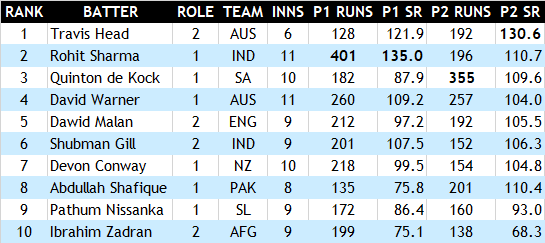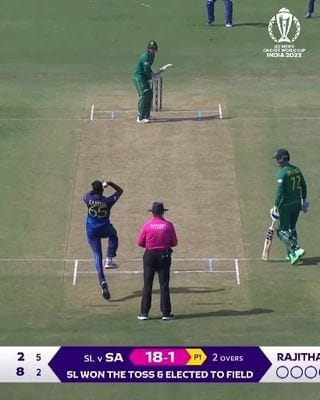2023 ODI World Cup: Best Tournament XI Pt. 1
“They pick themselves” is something you’ll often hear at the end of major tournaments, usually in reference to the big names having delivered big performances and therefore making themselves automatic picks for the Team of the Tournament.
In cricket, we have very traditional and, frankly, outdated ways of assessing players. We all seem to accept these tried and tested methods and so we go along with the flow of it as well. But if you could evaluate players differently? Cricinfo introduced Smart Stats some time back but it seems to have fallen of deaf ears for a lot of fans. The total impact measure is available in each scorecard but how many truly value that over whoever ends up being picked as Player of the Match?
For my Team of the Tournament, I wanted to evaluate candidates in my own way. I’m a big believer in roles, and so while some pundits went ahead and just stacked their team with the highest run scorers just to squeeze the biggest names in, I think it’s important to break down what each player contributes in each role and then assess their value properly.
Before getting into my picks, here are some of the Team of the Tournament choices by different outlets and their experts, highlighted are the names that made it across all five teams:
The Cricket Australia digital platform is exactly the kind of “let’s squeeze all the good players in with no regard for role” type selection I hate. Virat Kohli has owned No. 3 since stepping into the ODI scene, why would he be at No. 4? Aiden Markram batted at No. 4 all tournament and for the majority of his career, why is he at No. 5? Also, quite the interesting choice on their part to go with David Warner over both Travis Head and Rohit Sharma.
Enough ranting, let’s get to Part 1 of my selection. You’ll see why I’ve split this team selection process into two parts:
OPENERS
Everyone knows that Quinton de Kock, Rohit Sharma, Travis Head, and David Warner have been the best openers in the tournament. Beyond just knowing their overall run tallies and strike rates, it’s important to evaluate how they batted in each phase of the game to make these hair-splitting decisions between great players:
(Reminder: P1 = Overs 0.1-10, P2 = Overs 10.1-40, P3 = Overs 40.1-50)
What if, instead of just seeing total runs and overall strike rate, you saw this?
Openers rarely ever get to the P3 phase of the innings and so I don’t believe in assessing their stats in that phase. Their responsibility lies chiefly in how well they start, and then capitalize on that start in the middle phase. Just to give you some perspective in evaluating the third phase for openers, Quinton de Kock finished with 594 runs of which only his 174 against Bangladesh saw him bat in the final phase (he scored 57 off 24 and that 57 is the highest tournament tally for any opener in the final 10 overs). Eight of the 10 players on this list scored less than 20 runs in the final phase.
For me, De Kock had the tournament of his life with four centuries, two of which came against semifinalists Australia and New Zealand. His method was to be fairly conservative in the Powerplay as evidenced by his 87.9 strike rate, but no one capitalized on their starts like De Kock as evidenced by his staggering 355-run haul in P2, well ahead of any other opener. He’s slots in at the top of the order.
This now leaves me debating between Travis Head and Rohit Sharma. Sharma’s 401 runs in just the P1 phase is mind blogging, especially seeing that it came at the highest strike rate of anyone as well. My heart says Rohit, but what leaves me wanting is seeing that he had 196 runs in the P2 phase while Head at 192 despite having played five fewer innings. Head capitalized on his starts more often than Sharma (his P1 strike rate of 121.9 is nothing to sneeze at, either) and that’s how you win Player of the Match awards in three of the six matches you play including the semifinal and final.
India is so individualistic that Sharma’s selfless batting with no regard for his wicket stood out that much more. Scrutinizing over the subtle differences as this exercise demands, Sharma should be disappointed that for all his magnificent batting in the first phase, he didn’t make it out of the P1 phase in four of his final five innings and his knock against Netherlands was the exception where he lasted 20 P2 balls.
Note: Fakhar Zaman, Rachin Ravindra, and Mitchell Marsh played 4, 4, and 5 innings, respectively, as openers and that was too few to make the openers cut.
NO. 3, 4
As you can see, I’ve included all three phases for batters at No. 3 and 4. The breakdown of phases also shows the importance of evaluating No. 3s and No. 4s differently. Most No. 3s are in full anchor mode and know their responsibility is to ensure the score ticks over at a steady pace while also minimizing risk. No. 4s, as a result, are usually encouraged to take on more risk and keep the bowlers off balance.
Rachin Ravindra and Kusal Mendis are the only No. 3 batters who bat at a strike rate above 90 in P2, but it’s Ravindra’s ability that deserves more attention. Mendis’s high risk, high reward resulted in innings of 76 off 55 against South Africa and 122 off 77 against Pakistan in the first two matches of the tournament but just 96 runs from his final seven innings at an average of 13.71. Maybe taking over the captaincy after Dasun Shanaka’s injury had an impact as well but this is the challenge batters at No. 3 face.
No one has mastered that balance over the years like Kohli, and his 576 runs at a strike rate of 89.6 in the P2 phase is a colossal effort, even more so when considering that India played its final eight batting innings without the batting depth that Hardik Pandya provides and so Kohli’s wicket became all the more crucial. What would that strike rate have looked like if India was tasked with chasing bigger totals more often? We’ll never know but the benefit of the doubt goes to the greatest chaser of all-time.
That being said, it really makes Ravindra’s batting in this phase stand out that much more. He played six innings as a No. 3, and whether it was his first World Cup match where New Zealand was tasked with chasing down 282 or a crunch battle against Australia chasing 388, striking at 114 in the middle overs without ever really breaking a sweat was breathtaking to watch. While Ravindra was absolutely fantastic, I will give a slight nod to Kohli for the larger sample size and outplaying Ravindra when the two clashed in both India vs. New Zealand fixtures.
No. 4 is where you see the best batters in that role strike at a run-a-ball or higher, and considering Daryl Mitchell’s total tally, it makes his ability to strike at 111.6 in that phase the best pick for the position. He took on bowlers regularly in this phase, especially applying pressure on spinners early in overs with big hits. He was a special player to watch this tournament.
It’s a pity that Aiden Markram faded as the tournament went on, while Shreyas Iyer was on the opposite end of spectrum saving his best for the latter half of the tournament and scoring an exceptional 143 runs at a strike rate of 181 in the final phase. How he must wish he could have had just one of the play-and-misses that Travis Head had in the final. That’s cricket for you.
When you break down batting by phases, you get a better idea of why Babar Azam’s tournament was so underwhelming. He never applied real pressure on the bowlers at any point.
Note: Kane Williamson only played four innings at No. 3 and so was not included. He scored 256 runs at an average of 85.33. Mitch Marsh scored 252 runs in five innings at an average of 63.00 but that was largely due to his unbeaten 177 against Bangladesh.
NO. 5, 6
With No. 5 and 6, the first phase has little bearing on evaluating their performance. The 10 batters above combined for 32 runs in the first phase. KL Rahul coming in at 2/3 against Australia in the first match was a very rare exception to when batters in these positions usually arrive at the crease.
When I look at who the best No. 5 has been, it’s Heinrich Klaasen by a mile. The fact that he batted at that position and had an overall strike rate of 133.2 seems impossible. If you saw the way he was batting with David Miller in the semifinal against Australia, it becomes all the more unbelievable that he got out to Travis Head against the run of play. Klaasen plays spin beautifully and his ability to slap pressure back onto bowlers in the middle phase is second to none. Take a look back at some of the innings he’s played in this World Cup and even earlier in 2023 and you will be blown away. Striking at nearly 200 in P3 as a No. 5? What a player.
Rahul certainly faced tough circumstances against Australia twice, and his strike rate of 69.4 (136 off 196) in the P2 phase of both those innings combined is why his overall P2 strike rate suffers. Outside those two innings, he had a more palatable strike rate of 82.7 (182 off 220) in P2 but from an overall team process, I do think 82.7 is still below par when Kohli was already playing the anchor role to perfection. His acceleration in the final 10 shows he’s capable of more.
And then there’s No. 6. Many will tell you that Glenn Maxwell is an automatic pick here, but I don’t think it’s quite that straightforward. Maxwell played one of the greatest ODI innings of all-time with an unbeaten 201 against Afghanistan and also scored the fastest hundred in ODI World Cup history. Let’s not forget, he also managed to bowl 68 overs in this tournament at an economy rate of 4.81 and his six wickets include Rohit Sharma, Quinton de Kock, and Charith Asalanka. Not bad for a part-timer. In typical Maxwell fashion, though, he managed just 93 runs from his other seven innings at an average of 18.60.
That is why I think David Miller deserves legitimate consideration for his performances at No. 6. I thought he had himself an outstanding tournament and the Maxwell big shows make it easy to forget Miller had super impactful knocks of 39*(21), 34*(15), and 53(30) before the biggest innings of his life with 101 off 116 in the semifinal against Australia to give the Proteas something to bowl at. Even if you were to take away his century and the quickfire 53, Miller would still have an average of 33.67 and so was clearly the more consistent player. The manner in which he has matured over the years from the all or nothing player he used to be (and Maxwell still is) should be a lesson for many who come in with big expectations as an explosive hitter. There isn’t much to separate these two as fielders.
Do you prefer the consistent big hitter or the one who played a couple freak knocks? Ultimately, I’ve gone with Maxwell because of his ability to bowl but I hope you can see why this was a worthy debate.
I’d be a remiss if I didn’t spare a thought for Azmatullah Omarzai, who had himself a fantastic World Cup. He played a massive role in Afghanistan’s success with the way he batted with gusto in the middle overs and bowled with some zip, too, and it’s a shame he couldn’t complete his hundred against South Africa in their final group match.
Note: I think Pakistan need to sit Saud Shakeel down and let him know now is the time to capitalize on his talent and be a great No. 5. He’s 28-years-old, his batting is great to watch, but it never lasts long enough. 221 runs in the P2 phase at 96.5 in 7 innings is great but just 15 runs in P3 shows that he never capitalized.
There you have it, here’s my Top 6 for now:
Quinton de Kock (SA)
Travis Head (AUS)
Virat Kohli (IND)
Daryl Mitchell (NZ)
Heinrich Klaasen (SA)
Glenn Maxwell (AUS)
Part 2 will have the remaining five.











